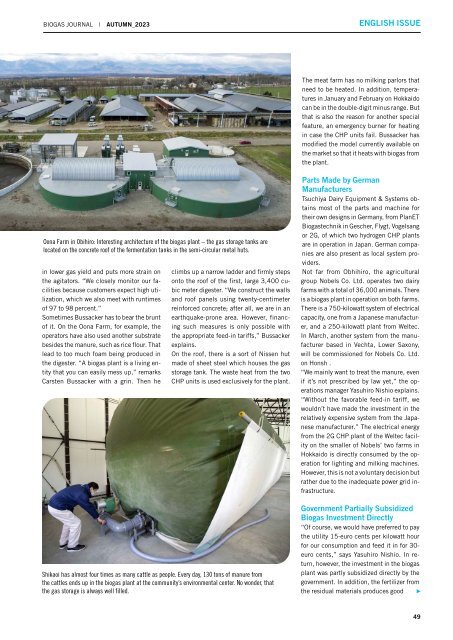Autumn 2023 EN
The German Biogas Association presents its autumn 2023 issue of the English BIOGAS journal.
The German Biogas Association presents its autumn 2023 issue of the English BIOGAS journal.
- No tags were found...
You also want an ePaper? Increase the reach of your titles
YUMPU automatically turns print PDFs into web optimized ePapers that Google loves.
BIOGAS JOURNAL | AUTUMN_<strong>2023</strong> <strong>EN</strong>GLISH ISSUE<br />
The meat farm has no milking parlors that<br />
need to be heated. In addition, temperatures<br />
in January and February on Hokkaido<br />
can be in the double-digit minus range. But<br />
that is also the reason for another special<br />
feature, an emergency burner for heating<br />
in case the CHP units fail. Bussacker has<br />
modified the model currently available on<br />
the market so that it heats with biogas from<br />
the plant.<br />
Oona Farm in Obihiro: Interesting architecture of the biogas plant – the gas storage tanks are<br />
located on the concrete roof of the fermentation tanks in the semi-circular metal huts.<br />
in lower gas yield and puts more strain on<br />
the agitators. “We closely monitor our facilities<br />
because customers expect high utilization,<br />
which we also meet with runtimes<br />
of 97 to 98 percent.”<br />
Sometimes Bussacker has to bear the brunt<br />
of it. On the Oona Farm, for example, the<br />
operators have also used another substrate<br />
besides the manure, such as rice flour. That<br />
lead to too much foam being produced in<br />
the digester. “A biogas plant is a living entity<br />
that you can easily mess up,” remarks<br />
Carsten Bussacker with a grin. Then he<br />
climbs up a narrow ladder and firmly steps<br />
onto the roof of the first, large 3,400 cubic<br />
meter digester. “We construct the walls<br />
and roof panels using twenty-centimeter<br />
reinforced concrete; after all, we are in an<br />
earthquake-prone area. However, financing<br />
such measures is only possible with<br />
the appropriate feed-in tariffs,” Bussacker<br />
explains.<br />
On the roof, there is a sort of Nissen hut<br />
made of sheet steel which houses the gas<br />
storage tank. The waste heat from the two<br />
CHP units is used exclusively for the plant.<br />
Shikaoi has almost four times as many cattle as people. Every day, 130 tons of manure from<br />
the cattles ends up in the biogas plant at the community’s environmental center. No wonder, that<br />
the gas storage is always well filled.<br />
Parts Made by German<br />
Manufacturers<br />
Tsuchiya Dairy Equipment & Systems obtains<br />
most of the parts and machine for<br />
their own designs in Germany, from PlanET<br />
Biogastechnik in Gescher, Flygt, Vogelsang<br />
or 2G, of which two hydrogen CHP plants<br />
are in operation in Japan. German companies<br />
are also present as local system providers.<br />
Not far from Obhihiro, the agricultural<br />
group Nobels Co. Ltd. operates two dairy<br />
farms with a total of 36,000 animals. There<br />
is a biogas plant in operation on both farms.<br />
There is a 750-kilowatt system of electrical<br />
capacity, one from a Japanese manufacturer,<br />
and a 250-kilowatt plant from Weltec.<br />
In March, another system from the manufacturer<br />
based in Vechta, Lower Saxony,<br />
will be commissioned for Nobels Co. Ltd.<br />
on Honshū.<br />
“We mainly want to treat the manure, even<br />
if it’s not prescribed by law yet,” the operations<br />
manager Yasuhiro Nishio explains.<br />
“Without the favorable feed-in tariff, we<br />
wouldn’t have made the investment in the<br />
relatively expensive system from the Japanese<br />
manufacturer.” The electrical energy<br />
from the 2G CHP plant of the Weltec facility<br />
on the smaller of Nobels’ two farms in<br />
Hokkaido is directly consumed by the operation<br />
for lighting and milking machines.<br />
However, this is not a voluntary decision but<br />
rather due to the inadequate power grid infrastructure.<br />
Government Partially Subsidized<br />
Biogas Investment Directly<br />
“Of course, we would have preferred to pay<br />
the utility 15-euro cents per kilowatt hour<br />
for our consumption and feed it in for 30-<br />
euro cents,” says Yasuhiro Nishio. In return,<br />
however, the investment in the biogas<br />
plant was partly subsidized directly by the<br />
government. In addition, the fertilizer from<br />
the residual materials produces good<br />
49

















